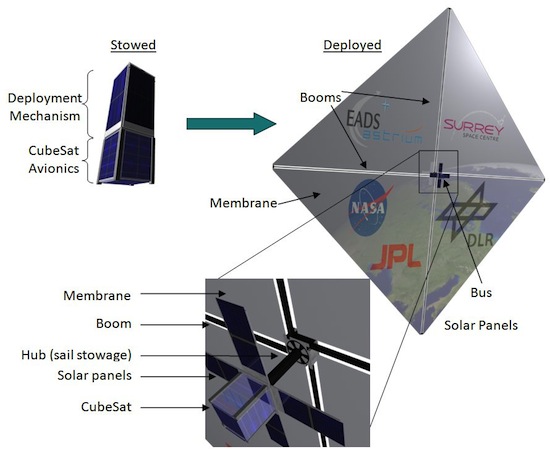DeorbitSail: A Spacecraft Mission to deploy sails in Space
DeorbitSail | A Spacecraft Mission to deploy sails in Space
The Deorbitsail project is a collaboration to build a 3U CubeSat sized satellite with a deployable sail that will demonstrate rapid deorbiting. The deorbiting capability of the Deorbitsail satellite is due to increased aerodynamic drag from the large surface area of the deployed sail in a Low Earth Orbit (LEO). According to the proposed concept, eventually the satellite will return to the Earth and burn up in the atmosphere. The project is funded by FP7 and this includes launch costs and the actual demonstration of deorbiting. ATHENA-SPU participates in this project in CubeSat subsystems as well as in testing, software, and the dissemination and communication of the results of the project.
- Mission Overview:
- top
Recent studies show an increasing probability of collisions between intact spacecraft and debris. The historical practice of abandoning spacecraft and upper stages at the end of mission life has resulted in 5,500 tons of space debris in low earth orbit. The uncontrolled growth of the space debris population has to be avoided in order to enable safe operations in space for the future. Space system operators need to take measures now and in future to conserve a space debris environment with tolerable risk levels, particularly in Low Earth Orbit (LEO) altitude regions.
Deorbitsail is a small satellite mission that will launch and deploy a 5-by-5-metre, four-quadrant sail to demonstrate deorbiting. The spacecraft will be based on a 3 unit (3U) CubeSat Standard structure, with dimensions close to 10 by 10 by 34 cm. Deorbitsail will be a satellite you could easily lift, but with power, communications, attitude control and data handling components in addition to its densely packed sail and deployment system. The sail will be able to change the satellite’s orbit through drag and solar radiation pressure.
Deorbiting simply means bringing the satellite back down to Earth. After the useful life of a satellite, it poses a risk to operational satellites in the same orbit. A deorbiting system moves the satellite out of crowded orbits, either to an area of space that isn't heavily populated or back down to Earth. Deorbitsail will return to Earth and burn up in the atmosphere.
- Mission Objectives:
- The main objectives of this project involve the production of a satellite that can perform the following tasks:
- Fully deploy a 5 m by 5 m sail from a 3U CubeSat sized package.
- Deorbit from an altitude of 600 km in less than 180 days.
- Provide Photographic, Orbit trajectory and Attitude data confirmation functions.
- The deorbiting shall be accomplished with a design that provides the following functions:
- Three-axis control of the s/c sufficient to maintain pointing relative to velocity vector.
- Deployable solar panels to sufficiently power all subsystems.
- Imaging capability to photograph the deployed sail.
- Space to ground communications capability.
- top
Phases of the Mission:
- DeorbitSail Partners:
 Surrey Space Centre - University of Surrey (leader)
Surrey Space Centre - University of Surrey (leader) ATHENA Research Center/Space Programmes Unit
ATHENA Research Center/Space Programmes Unit Jet Propulsion Laboratory Caltech
Jet Propulsion Laboratory Caltech Deutsches Zentrum fόr Luft- und Raumfahrt (DLR)
Deutsches Zentrum fόr Luft- und Raumfahrt (DLR) Astrium S.A.S
Astrium S.A.S Stellenbosch University
Stellenbosch University University of Patras
University of Patras Middle East Technical University
Middle East Technical University Surrey Satellite Technology Limited
Surrey Satellite Technology Limited ISIS Netherlands
ISIS Netherlands
